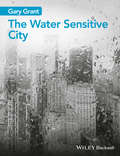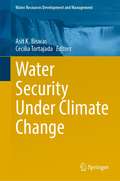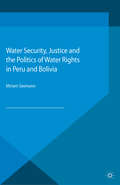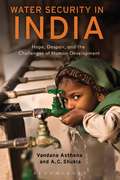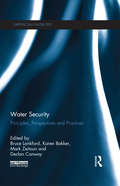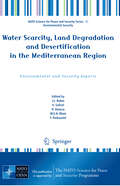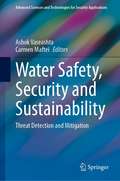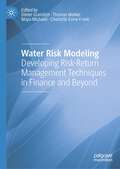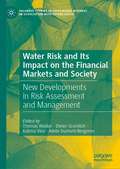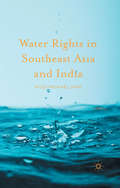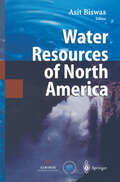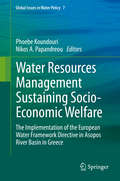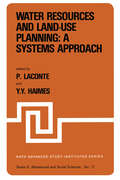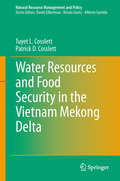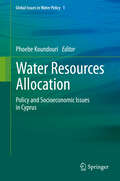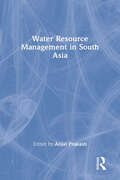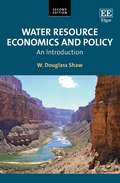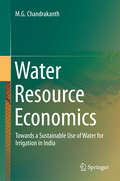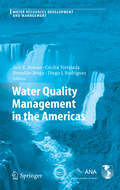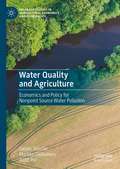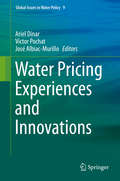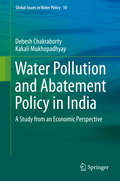- Table View
- List View
The Water Sensitive City
by Gary GrantThis book advocates a more thoughtful approach to urban water management. The approach involves reducing water consumption, harvesting rainwater, recycling rainwater and adopting Sustainable Drainage Systems (SuDS) where surface water is not sent straight to drains but is intercepted by features like green roofs, rain gardens, swales and ponds.Cities in particular need to change the existing linear model of water consumption and use to a more circular one in order to survive. The Water Sensitive City brings together the various specialised technical discussions that have been continuing for some time into a volume that is more accessible to designers (engineers and architects), urban planners and managers, and policymakers.
Water Security Under Climate Change (Water Resources Development and Management)
by Asit K. Biswas Cecilia TortajadaThis book highlights the likely impacts of climate change in terms of global and national water securities, how different countries are attempting to address these complex problems and to what extent they are likely to succeed. A major global concern at present, especially after the social and economic havoc that has been caused by COVID-19 in only one year, is how we can return to earlier levels of economic development patterns and then further improve the process so that sustainable development goals are reached to the extent possible by 2030, in both developed and developing countries. Mankind is now facing two existential problems over the next several decades. These are climate change and whether the world will have access to enough water to meet all its food, energy, environment and health needs. Much of expected climate change impacts can be seen through the lens of extreme hydrological events, like droughts, floods and other extreme hydrometeorological events.Chapter 7 is available open access under a Creative Commons Attribution 4.0 International License via link.springer.com.Chapter 12 is available open access under a Creative Commons Attribution-NonCommercial 4.0 International License via link.springer.com.
Water Security, Justice and the Politics of Water Rights in Peru and Bolivia (Environment, Politics and Social Change)
by Miriam SeemannThe author scrutinizes the claim of policy-makers and experts that legal recognition of local water rights would reduce water conflict and increase water security and equality for peasant and indigenous water users. She analyzes two distinct 'top-down' and 'bottom-up' formalization policies in Peru and Bolivia - neoliberal the former, indigenist-socialist the latter. The policies have intended and unintended consequences and impact on marginalized peasants and the complex inter-legal systems for providing water security on the ground. This study seeks to debunk the official myth of the need to create state-centric, top-down legal security in complex, pluralistic water realities. The engagement between formal and alternative 'water securities' and controversial notions of 'rightness' is interwoven and contested; a complex setting is unveiled that forbids one-size-fits-all solutions. Peru's and Bolivia's case studies demonstrate how formalization policies, while aiming to enhance inclusion, in practice actually reinforce exclusion of the marginalized. Water rights formalization is certainly no panacea.
Water Security in India: Hope, Despair, and the Challenges of Human Development
by Vandana Asthana A. C. ShuklaFew people actively engaged in India's water sector would deny that the Indian subcontinent faces serious problems in the sustainable use and management of water resources. Water resources in India have been subjected to tremendous pressures from increasing population, urbanization, industrialization, and modern agricultural methods. The inadequate access to clean drinking water, increase in water related disasters such as floods and droughts, vulnerability to climate change and competition for the resource amongst different sectors and the region poses immense pressures for sustainability of water systems and humanity. Water Security in India addresses these issues head on, analyzing the challenges that contemporary India faces if it is to create a water-secure world, and providing a hopeful, though guarded, road-map to a future in which India's life-giving and life-sustaining fresh water resources are safe, clean, plentiful, and available to all, secured for the people in a peaceful and ecologically sustainable manner.
Water Security in India: Hope, Despair, and the Challenges of Human Development
by Vandana Asthana A. C. ShuklaFew people actively engaged in India's water sector would deny that the Indian subcontinent faces serious problems in the sustainable use and management of water resources. Water resources in India have been subjected to tremendous pressures from increasing population, urbanization, industrialization, and modern agricultural methods. The inadequate access to clean drinking water, increase in water related disasters such as floods and droughts, vulnerability to climate change and competition for the resource amongst different sectors and the region poses immense pressures for sustainability of water systems and humanity. Water Security in India addresses these issues head on, analyzing the challenges that contemporary India faces if it is to create a water-secure world, and providing a hopeful, though guarded, road-map to a future in which India's life-giving and life-sustaining fresh water resources are safe, clean, plentiful, and available to all, secured for the people in a peaceful and ecologically sustainable manner.
Water Security: Principles, Perspectives and Practices
by Bruce Lankford Karen Bakker Mark Zeitoun Declan ConwayThe purpose of this book is to present an overview of the latest research, policy, practitioner, academic and international thinking on water security—an issue that, like water governance a few years ago, has developed much policy awareness and momentum with a wide range of stakeholders. As a concept it is open to multiple interpretations, and the authors here set out the various approaches to the topic from different perspectives. Key themes addressed include: Water security as a foreign policy issue The interconnected variables of water, food, and human security Dimensions other than military and international relations concerns around water security Water security theory and methods, tools and audits. The book is loosely based on a masters level degree plus a short professional course on water security both given at the University of East Anglia, delivered by international authorities on their subjects. It should serve as an introductory textbook as well as be of value to professionals, NGOs, and policy-makers.
Water Security: Principles, Perspectives and Practices
by Bruce Lankford Karen Bakker Mark Zeitoun Declan ConwayThe purpose of this book is to present an overview of the latest research, policy, practitioner, academic and international thinking on water security—an issue that, like water governance a few years ago, has developed much policy awareness and momentum with a wide range of stakeholders. As a concept it is open to multiple interpretations, and the authors here set out the various approaches to the topic from different perspectives. Key themes addressed include: Water security as a foreign policy issue The interconnected variables of water, food, and human security Dimensions other than military and international relations concerns around water security Water security theory and methods, tools and audits. The book is loosely based on a masters level degree plus a short professional course on water security both given at the University of East Anglia, delivered by international authorities on their subjects. It should serve as an introductory textbook as well as be of value to professionals, NGOs, and policy-makers.
Water Scarcity, Land Degradation and Desertification in the Mediterranean Region: Environmental and Security Aspects (NATO Science for Peace and Security Series C: Environmental Security)
by Uriel Safriel Raul Daussa Winfried Blum Fausto Pedrazzini Jose RubioBased on the suggestions made by the speakers of Plenary Session IV “Ch- lenges to the management of water resources and to countering deserti cation in the Mediterranean region” during the 15th Economic and Environmental Forum, the OCEEA proposed to organize a workshop on “Water Scarcity, Land Degra- tion and Deserti cation in the Mediterranean region – Environment and Security Aspects”. In order to build on common synergies, OSCE sought co-operation with c- leagues from NATO, in particular from the Science for Peace and Security P- gramme. NATO has a longstanding expertise on the issue and had organised in Valencia, in December 2003, a NATO scienti c workshop on “Deserti cation and Security in the Mediterranean Region”. The objective of the new proposed wo- shop would be to broaden its focus from the scienti c community to include also policy makers. 1 The workshop, aimed at government of cials from the Mediterranean Region, gathered representatives of Water management, Land degradation and Desert- cation Departments of Ministries of Environment and representatives from the Ministries of Foreign Affairs. In addition, policy makers, scientists and experts were also invited. The aim was to discuss how the OSCE, NATO and other c- petent organizations like the UNCCD, UNEP, MAP, and the EU could play a role in ensuring that environment and security linkages in terms of water scarcity, land degradation and deserti cation are addressed in the Mediterranean Region.
Water Safety, Security and Sustainability: Threat Detection and Mitigation (Advanced Sciences and Technologies for Security Applications)
by Ashok Vaseashta Carmen MafteiThis book focuses on threats, especially contaminants, to drinking water and the supply system, especially in municipalities but also in industrial and even residential settings. The safety, security, and suitability landscape can be described as dynamic and complex stemming from necessity and hence culpability due to the emerging threats and risks, vis-a-vis globalization resulting in new forms of contaminants being used due to new technologies. The book provides knowledge and guidance for engineers, scientists, designers, researchers, and students who are involved in water, sustainability, and study of security issues. This book starts out with basics of water usage, current statistics, and an overview ofwater resources. The book then introduces different scenarios of safety and security and areas that researchers need to focus. Following that, the book presents different types of contaminants – inadvertent, intentional, or incidental. The next section presents different methodologies of contamination sensing/detection and remediation strategies as per guidance and standards set globally. The book then concludes with selected chapters on water management, including critical infrastructure that is critical to maintaining safe water supplies to cities and municipalities. Each chapter includes descriptive information for professionals in their respective fields. The breadth of chapters offers insights into how science (physical, natural, and social) and technology can support new developments to manage the complexity resident within the evolving threat and risk landscape.
Water Risk Modeling: Developing Risk-Return Management Techniques in Finance and Beyond
by Dieter Gramlich Thomas Walker Maya Michaeli Charlotte Esme FrankThis book sheds light on the topic of financial water risk by examining the modeling challenges associated with physical, regulatory, and reputational water risk in finance. It explores various approaches to operationalize water risk from a financial analysis, investment management, and climate science perspective. The analysis of tools to assess water risk provides the basis for the development of appropriate risk-return management techniques in finance and beyond. This book provides new insights by focusing on financial water threats and their related opportunities. It will be of interest to both academics and practitioners who work at the interface of finance, economics, nature, and society.
Water Risk and Its Impact on the Financial Markets and Society: New Developments in Risk Assessment and Management (Palgrave Studies in Sustainable Business In Association with Future Earth)
by Thomas Walker Dieter Gramlich Kalima Vico Adele Dumont-BergeronWater risks, including the lack of access to fresh water for personal and industrial use, droughts, floods, and water contamination, are problems that are not new, yet, they are amplifying in the face of climate change, population growth, and rapid economic development. Properly identifying, measuring, and managing these risks as well as taking advantage of related mitigation opportunities is essential for the future well-being of firms across various industries, investors who invest in these firms, local and federal governments, and ultimately our society as a whole. This edited book sheds light on this topic by examining the unique measurement and modelling challenges associated with either the scarcity or overabundance of water and their interaction with finance and society. Specifically, it explores approaches to assess and operationalize water risk, examines the vulnerability of institutions and markets, and discusses strategies for risk mitigation.
Water Rights in Southeast Asia and India
by Ross Michael PinkThis fascinating book examines the paramount human rights issue of our time: clean drinking water. Pollution, population surge, and climate change will deprive an estimated 2 billion citizens of this fundamental right by 2050. The author argues for the need to establish innovative, sustainable practices to safeguard this precious human right.
Water Resources of North America
by Asit K. BiswasLeonardo da Vinci, the eminent Renaissance scholar and philosopher said, "water is the driver of nature". Many may have considered it to be an overstatement in the past, but at the beginning of the third millennium, no sane individual would disagree with Leonardo's view. Water is becoming an increasingly scarce resource for most of the world's citizens. The current trends indicate that the overall situation is likely to deteriorate further, at least for the next two decades, unless the water profession eschews its existing "business as usual" practices, which can only allow incremental changes to occur. Somewhat surprisingly, the water profession as a whole neither realised nor appreciated the gravity of the global water situation as late as 1990, even though a few serious scholars have been pointing out the increasing criticality of the situation from around 1982. For example, the seriousness of the crisis was not a major issue, either at the International Conference on W ater and the Environment, which was organised by the UN system in Dublin and also at the UN Conference on Environment and Development at Rio de Janeiro. Held in 1992, both are considered to be important events for the water sector of the past decade. It is now being increasingly recognised that the Dublin Conference was poorly planned and organised, and thus not surprisingly it produced very little, if any, worthwhile and lasting results.
Water Resources Management Sustaining Socio-Economic Welfare: The Implementation of the European Water Framework Directive in Asopos River Basin in Greece (Global Issues in Water Policy #7)
by Phoebe Koundouri Nikos A. PapandreouThe aim of this book is to offer a river-basin management plan which is directly implementable and consistent with the European Union -Water Framework Directive (EU WFD).The contributors, who are leading world experts in their respective fields, develop an integrated water resources management plan for the Asopos river basin in Greece which is economically efficient, socially equitable and environmentally sustainable. The program offers explicit technical and investment solutions, socioeconomic and legal instruments and recommendations for institutional restructuring. The introductory chapter describes the water situation in Greece and assesses the potential of timely implementation of the EU WFD. Special emphasis is given to the cost-recovery principle. Chapter 2 introduces the case study area highlighting the particular pressures and impacts as well as the environmental functions and values of Asopos River and Oropos Lagoon. Chapters 3 and 4 focus on the economic characterisation of Asopos River Basin in order to identify the economic sectors and social groups that will bear the cost and benefits of the implementation of the EU WFD. In particular, Chapter 3 presents the main water uses and pricing for water supply in the industrial and the agricultural sectors. Chapter 4 completes the baseline appraisal, presenting the details of water use by the residential and touristic sectors. The following chapters assess valuation and decision-making tools from a range of perspectives, including agricultural needs, valuing the impacts of industrial activity, the costs and benefits of environmental preservation and management. The water resources management plan is presented in Chapter 9; the concluding chapter offers recommendations on institutional changes and presents the lessons learned as resources applicable to other river basins in Greece and elsewhere. The book applies state-of-the art market and non-market valuation methods to estimate water demands in the residential, industrial, agricultural, tourism, environmental and health sectors and to balance these, over time and space, with water supply. Given the well-known challenge of managing natural resources in a way that maximizes and sustains social welfare, this book will provide an invaluable point of reference for applied researchers and policy makers working in water resources management.
Water Resources Engineering Risk Assessment (Nato ASI Subseries G: #29)
by Jacques GanoulisAlthough many theoretical developments have been achieved in recent years, the progress both in understanding and application of risk and reliability analysis in water resources and environmental engineering remains slow. One of the reasons seems to be the lack of training of engineers with phenomena of statistical nature, including optimum cost and benefit decisions under uncertainty. This book presents, in a unified and comprehensive framework, the various aspects of risk and reliability in bothwater quantity and quality problems. The topics covered include uncertainty analysis of water quantity and quality data, stochastic simulation of hydrosystems, decision theory under uncertaintyand case studies. Methods for risk analysis of extremes in hydrology, groundwater clean-up, river and coastal pollution as well as total risk management are presented.
Water Resources and Land-Use Planning: Proceedings of the NATO Advanced Study Institute on: “Water Resources and LAnd-Use Planning” Louvain-la-Neuve, Belgium, July 3–14, 1978 (NATO Science Series D: #11)
by P. Laconte Y. Y. HaimesThis volume constitutes the proceedings of the NATO Advanced Study Institute on Water Resources and Land-Use Planning that was held in Louvain-la-Neuve, Belgium, July 3-14, 1978. In the pre paration of the two-week NASI, we identified 12 major goals and objectives, knowing well, at the time, that the satisfaction of all priorities would be an impossible task. It is instructive that we share these early goals and objectives with our readers prior to evaluating the NASI's contribution. 1. Relate and analyze water resources (water quantity and quality, surface and groundwater) and related land resources in a multi objective framework. 2. Identify and relate the scientific, technological, institu tional, societal, legal and political aspects of water and related land resources to policy decisions. 3. Promote and foster the transfer of technological information and assistance in water related land resources within the var ious levels of government. 4. Analyze the above three objectives and goals in light of the experience gained by the institute participants via case studies. 5. Improve communication and understanding among the various dis ciplines involved in water and related land resources. 6. Discuss and analyze the applicability of advanced planning methodologies germane to water and related land resources. 7. Identify current and projected future water and related land resources problems and issues and suggest ways to alleviate their respective and interrelated impacts.
Water Resources and Food Security in the Vietnam Mekong Delta (Natural Resource Management and Policy #44)
by Tuyet L. Cosslett Patrick D. CosslettThe Mekong River has been a main source of conquest, conflict, and cooperation in the Southeast Asian region. Much has been written on the vital and critical importance of the Mekong River fresh water to the sustainable economic development of the Mekong Delta. This book selects the Mekong Delta as a case study of regional cooperation for water and food security for not only for Vietnam but also for the world in a new century of global economy. It focuses not only on the Mekong Delta as an integral part of the River but also on Can Tho City and its 12 provinces that produce over 50 percent of the country’s rice output and 60 percent of total fishery output. The book takes a micro approach to examine how each province is adapting to the twin threats of mainstream dams construction and climate change, reducing fresh water flows and increasing saline infusions on its present and future economy. Finally, it reviews the roles of international institutional arrangements, namely the Mekong Committee and the Mekong River Commission, in promoting regional cooperation among the riparian states for political and economic development of the Mekong Delta.
Water Resources Allocation: Policy and Socioeconomic Issues in Cyprus (Global Issues in Water Policy #1)
by Phoebe KoundouriThe dilemma facing Cyprus—that of limited water supplies (both in terms of quantity and quality) in the face of steadily increasing water demand, coupled with a fragmented institutional structure of the water sector—is characteristic of most arid and semi-arid countries all over the world. Another common characteristic of Cyprus is that the water management administrative boundaries there do not coincide with the hydrological ones, while the ongoing political problem of the island creates significant administration problems.
Water Resource Management in South Asia
by Anjal PrakashThis cluster of books presents innovative and nuanced knowledge on water resources, based on detailed case studies from South Asia—India, Bangladesh, Bhutan, Nepal, Pakistan, and Sri Lanka. In providing comprehensive analyses of the existing economic, demographic and ideological contexts in which water policies are framed and implemented, the volumes argue for alternative, informed and integrated approaches towards efficient management and equitable distribution of water. These also explore the globalization of water governance in the region, particularly in relation to new paradigms of neoliberalism, civil society participation, integrated water resource management (IWRM), public–private partnerships, privatization, and gender mainstreaming. These volumes will be indispensable for scholars and students of development studies, environmental studies, natural resource management, governance and public administration, particularly those working on water resources in South Asia. They will also be useful for policymakers and governmental and non-governmental organizations.
Water Resource Economics and Policy: An Introduction
by W. D. ShawEconomic issues arise in almost every water policy context. Water is of most concern when scarce, but physical scarcity is often overcome as human beings move water from place to place, sometimes creating monumental structures. The roles that cost and economic value play in water resource allocation are implicit, but often poorly understood. This second edition clarifies the role of economics and offers material that can be applied to water resource allocation problems around the world. Topics covered include: groundwater, floods and droughts, in situ uses of water, and institutions and law. New to the book is an exploration of water issues outside the United States as well as a new application of behavioral and experimental economics to the topic. A concise introduction to issues of water quality and quantity in both urban and agricultural settings, Water Resource Economics and Policy will be a valuable resource or text for students and researchers in the fields of agricultural economics, geography, law, and hydrology. Those involved in water resource agencies and private utilities will also find the book a useful reference.
Water Resource Economics: Towards a Sustainable Use of Water for Irrigation in India
by M.G. ChandrakanthThis book uses resource economics costing approaches incorporating externalities to estimate the returns for the country’s irrigation and demonstrates how underestimating the cost of water leads farmers to overestimate profits. The importance of the subject can be judged in light of the fact that India is the largest user of groundwater both for irrigation and for drinking purposes, pumping twice as much as the United States and six times as much as Europe.Despite water’s vital role in ensuring economic security for the nation and farmers alike by supporting more than 70% of food production, water resource economists are yet to impress upon farmers and policymakers the true value of water and the urgent need for its sustainable extraction, recharge and use. In an endeavor to promote more awareness, the book further delineates the roles of the demand side and supply side in the economics of irrigation, and explains how the cost of water varies with the efforts to recharge it, crop patterns, degrees of initial and premature well failure and degrees of externalities. It also discusses the importance of micro-irrigation in the economics of saving water for irrigation, estimating the marginal productivity of water and how it improves with drip irrigation, the economics of water sharing and water markets, optimal control theory in sustainable extraction of water, payment of ecosystem services for water and how India can effectively recover.In closing, the book highlights the role of socioeconomic and hydrogeological factors in the economics of irrigation, which vary considerably across hard rock areas and the resulting limitations on generalizing.
Water Quality Management in the Americas (Water Resources Development and Management)
by Asit K. Biswas Cecilia Tortajada Benedito Braga Diego J. RodriguezThis study presents for the first time an independent and authoritative analysis of water quality management in North and South America, and discusses the practices and future implications of the impacts of the current practices in the different countries of the hemisphere. Includes in-depth case studies analyzing water quality management practices at country and state levels, especially in terms of their effectiveness and overall impact.
Water Quality and Agriculture: Economics and Policy for Nonpoint Source Water Pollution (Palgrave Studies in Agricultural Economics and Food Policy)
by James Shortle Markku Ollikainen Antti IhoWater pollution control has been a top environmental policy priority of the world’s most developed countries for decades, and the focus of significant regulation and public and private spending. Yet, significant water quality problems remain, and trends for some pollutants are in the wrong direction. This book addresses the economics of water pollution control and water pollution control policy in agriculture, with an aim towards providing students, environmental policy analysts, and other environmental professionals with economic concepts and tools essential to understanding the problem and crafting solutions that can be effective and efficient. The book will also examine existing policies and proposed reforms in the developed world. Although this book addresses and has a general applicability to major water pollutants from agriculture (e.g., pesticides, pharmaceuticals, sediments, nutrients), it will focus on the sediment and nutrient pollution problem. The economic and scientific foundations for pollution management are best developed for these pollutants, and they are currently the top priorities of policy makers. Accordingly, the authors provide both highly salient and informative cases for developing concepts and methods of general applicability, with high profile examples such as the Chesapeake Bay, Lake Erie, and the Gulf of Mexico Dead Zone in the US; the Baltic Sea in Northern Europe; and Lake Taupo in New Zealand.
Water Pricing Experiences and Innovations (Global Issues in Water Policy #9)
by Ariel Dinar Víctor Pochat José Albiac-MurilloWater pricing to achieve conservation in scarce water resources is a major policy challenge. This book provides credible evidence from water pricing experiences in various countries around the world. The book chapters, written by experts in water pricing from various countries, documents the past 10 to 15 years of water pricing experiences in Australia, Brazil, Canada, China, Colombia, France, India, Israel, Italy, Mexico, The Netherlands, New Zealand, South Africa and Spain. The book includes also several chapters that review innovations in water pricing in various countries, such as new reform mechanisms, achieving social objectives via water pricing, achieving revenue recovery, water use efficiency and customer equity, and charging the poor.
Water Pollution and Abatement Policy in India: A Study from an Economic Perspective (Global Issues in Water Policy #10)
by Debesh Chakraborty Kakali MukhopadhyayIndia has been traditionally well-endowed with large freshwater reserves, but increasing population, urbanization and agricultural growth in recent decades are causing overexploitation of surface and groundwater. As consumption of water grows, wastewater increases significantly and in the absence of proper measures for treatment and management, is polluting existing freshwater reserves. As a result, water pollution has emerged as one of the nation’s gravest environmental threats.This book draws a link between water pollution generated by different industries and the various economic activities of the Indian economy using the Input-output framework. It constructs a detailed water pollution coefficient matrix involving different types of water pollutants. The book estimates the total amount of water pollution generated directly and indirectly in different sectors and activities, and also calculates the water pollution content in India’s foreign trade sector. It also accounts for defensive expenditure from water pollution and estimates Green GDP for the extent and scope of environmental challenges. Analysis of the result indicates the variation in the pollution content of different economic activities. Finally, the book offers a portfolio of policies and assesses the implications of such policies on pollution generation in India.
